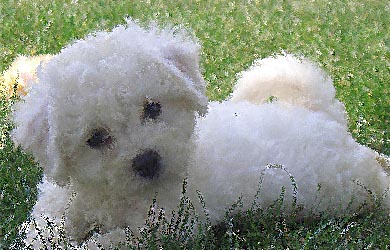 This article looks at the a small companion dog often just thought of as a lap dog. Always remember that temperament and grooming regime are very important for the health of long haired dogs like the bichon !
This article looks at the a small companion dog often just thought of as a lap dog. Always remember that temperament and grooming regime are very important for the health of long haired dogs like the bichon !
Bichon Frise
The bichon frise (meaning ‘curly lap dog’ in French) has a very old origin as far back as the 13th century. It is the culmination of a Poodle and a Barbet Water Spaniel. While it has a long and colorful history, in modern times it is considered a companion dog and show dog. Its looks are often mistaken for a Maltese terrier.
While its appearance (cuteness factor) means that is often selected by woman as a companion dog, its history suggests that it has a much greater potential. It is known to be intelligent, independent and affectionate. But rather than being a couch dog, given the chance the breed is bold and quite alert.
It is also known to be one of the happiest dogs around, but craves human companionship, which can lead to separation anxiety if not trained correctly. It makes a perfect family dog, and will expect to be taken on all social outgoings – which is fine as it gets along with all manner of people and dogs.
Bichon Frise size: These little fellows only grow to 23-30 cm and weigh only 3-5 kg.
Bichon Frise Grooming. Mostly owners either let the dog grow its coat into a natural round fluffy appearance or give it a traditional poodle cut.
It is recommended that its coat is groomed regularly 4-6 weeks for cuts, and bathed monthly to maintain coat oils. The bichon frise is also quite susceptible to flea bites, so maintaining a preventative parasite schedule is vital.
Maintain hair clearance around the eyes and ears as required. Clean eyes regularly to reduce the chance of infection. It has very low shedding.
It must be remembered that while it is a small fluffy friendly dog, that like all other dogs, regular walking, discipline and then affection are what will keep it friendly and happy. If its needs are not met, it can be known to whine, cry and bark.